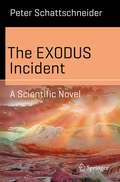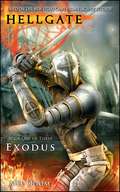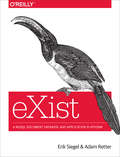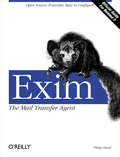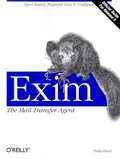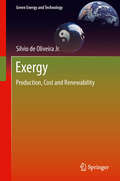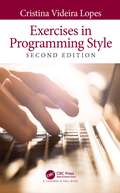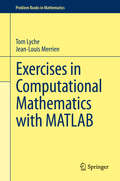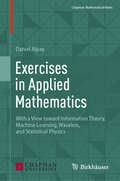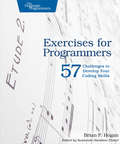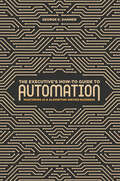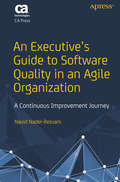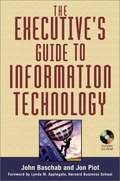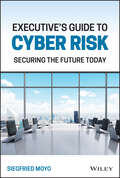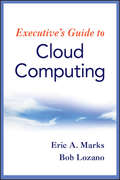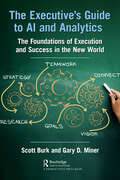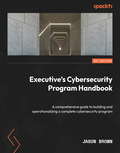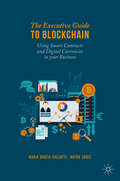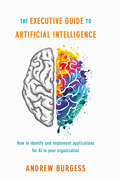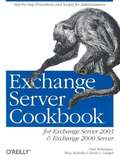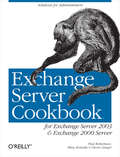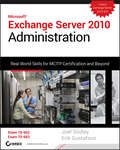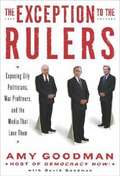- Table View
- List View
The EXODUS Incident: A Scientific Novel (Science and Fiction)
by Peter SchattschneiderIn the near future, Earth is suffering from climate change, famines, and fundamentalism. A global nuclear war is imminent. Interstellar probes from the Breakthrough Starshot project initiated by J. Milner and S. Hawking have discovered a habitable planet in the stellar system Proxima Centauri, just in time for the exodus of the elites. On board the EXODUS starship, the crew starts to experience strange things. The voyage to Atlantis, the new home for mankind, enters a mysterious and disquieting territory, where conspiracy theories about what is real and what is virtual emerge. THE EXODUS INCIDENT is a novel about an interstellar journey, which connects science to virtual realities and epistemology. In the guise of a final investigative report, a scientific treatise discusses the physics and mathematics behind the story: the starship, the fusion thruster, the target planet, and the journey, addressing anomalous effects which involve relativistic speed and deep space environments.
Exodus (Hellgate: London #1)
by Mel OdomLONDON, 2038. The once-great city lies in ruins. A massive gash in the fabric of our reality roils against the horizon as it blends into a permanently darkened sky. The world as we know it has come to an end. Demons, the visions of our nightmares, walk the Earth. Mankind, driven in retreat to the sanctuary of the Underground, struggles to survive the Hellish apocalypse. Among the survivors are those who foresaw the coming of the darkness, those who see it as an opportunity to improve the standing of man, and those who seek revenge for what was lost. All are now banding together in the shadows, arming themselves with futuristic weapons and arcane spells designed for one purpose -- to battle the demonic hordes and take back their world.
eXist
by Adam Retter Erik SiegelGet a head start with eXist, the open source NoSQL database and application development platform built entirely around XML technologies. With this hands-on guide, you'll learn eXist from the ground up, from using this feature-rich database to work with millions of documents to building complex web applications that take advantage of eXist's many extensions.If you're familiar with XML--as a student, professor, publisher, or developer--you'll find that eXist is ideal for all kinds of documents. This book shows you how to store, query, and search documents with XQuery and other XML technologies, and how to construct applications on top of the database with tools such as eXide and eXist's built-in development environment.Manage both data-oriented and text-oriented markup documents securelyBuild a sample application that analyzes and searches Shakespeare's playsGo inside the architecture and learn how eXist processes documentsLearn how to work with eXist's internal development environmentChoose among various indexes, including a full-text index based on Apache LuceneDive into eXist's APIs for integrating or interacting with the databaseExtend eXist by building your own Triggers, Scheduled Tasks, and XQuery extension modules
Exim: The Mail Transfer Agent
by Philip HazelExim delivers electronic mail, both local and remote. It has all the virtues of a good postman: it's easy to talk to, reliable, efficient, and eager to accommodate even the most complex special requests. It's the default mail transport agent installed on some Linux systems, runs on many versions of Unix, and is suitable for any TCP/IP network with any combination of hosts and end-user mail software. Exim is growing in popularity because it is open source, scalable, and rich in features such as the following: Compatibility with the calling interfaces and options of Sendmail (for which Exim is usually a drop-in replacement) Lookups in LDAP servers, MySQL and PostgreSQL databases, and NIS or NIS+ services Support for many kinds of address parsing, including regular expressions that are compatible with Perl 5 Sophisticated error handling Innumerable tuning parameters for improving performance and handling enormous volumes of mail Best of all, Exim is easy to configure. You never have to deal with ruleset 3 or worry that a misplaced asterisk will cause an inadvertent mail bomb. While a basic configuration is easy to read and can be created quickly, Exim's syntax and behavior do get more subtle as you enter complicated areas like virtual hosting, filtering, and automatic replies. This book is a comprehensive survey that provides quick information for people in a hurry as well as thorough coverage of more advanced material.
Exim
by Philip HazelExim is the default mail transport agent installed on some Linux systems; it runs on many versions of Unix and is suitable for any TCP/IP network with any combination of hosts and end-user mail software. It is open source, scalable, rich in features, and--best of all--easy to configure. This official guide is written by Philip Hazel, the creator of Exim.
Exhibiting Photography: A Practical Guide to Displaying Your Work
by Shirley ReadYou have the camera, you have the skills, and you have the pictures. Now what? Author Shirley Read expertly leads you through the world of exhibiting your photography one minute detail at a time. From finding a space and designing the exhibition to actually constructing a show and publicizing yourself, every aspect of exhibiting your photography is touched upon and clarified with ample detail, anecdotes, and real life case studies. In this new and expanded second edition, Shirley Read further illuminates the world of social networking, exhibiting, and selling photography online so your work is always shown in the best light. Packed with photos of internationally successful exhibitions, check lists, and invaluable advice, this essential reference guide will help amateur and professional photographers alike successfully showcase their bodies of work with confidence and finesse.
Exergy: Production, Cost and Renewability
by Silvio de Oliveira JuniorBridging the gap between concepts derived from Second Law of Thermodynamics and their application to Engineering practice, the property exergy and the exergy balance can be a tool for analyzing and improving the performance of energy conversion processes. With the exergy analysis it is possible to evaluate the performance of energy conversion processes not only on a thermodynamics basis but also by including production costs and environmental aspects and impacts of the studied processes. This comprehensive approach of the use of energy has, as one of the most important feature, the identification of sustainable ways of energy resources utilization. Based on the fundamentals of the exergy concept, its calculation, graphical representations and exergy balances evaluation, Exergy: Production Cost And Renewability describes the application of detailed exergy and thermoeconomic analysis to power plants and polygeneration systems, petroleum production and refining plants (including hydrogen production), chemical plants, biofuel production routes, combined production of ethanol and electricity, aircraft systems design, environmental impact mitigation processes and human body behavior. The presented case studies aim at providing students, researchers and engineers with guidelines to the utilization of the exergy and thermoeconomic analysis to model, simulate and optimize real processes and industrial plants.
Exercises in Programming Style
by Cristina Videira LopesThe first edition of Exercises in Programming Style was honored as an ACM Notable Book and praised as "The best programming book of the decade." This new edition retains the same presentation but has been upgraded to Python 3, and there is a new section on neural network styles. Using a simple computational task (term frequency) to illustrate different programming styles, Exercises in Programming Style helps readers understand the various ways of writing programs and designing systems. It is designed to be used in conjunction with code provided on an online repository. The book complements and explains the raw code in a way that is accessible to anyone who regularly practices the art of programming. The book can also be used in advanced programming courses in computer science and software engineering programs. The book contains 40 different styles for writing the term frequency task. The styles are grouped into ten categories: historical, basic, function composition, objects and object interactions, reflection and metaprogramming, adversity, data-centric, concurrency, interactivity, and neural networks. The author states the constraints in each style and explains the example programs. Each chapter first presents the constraints of the style, next shows an example program, and then gives a detailed explanation of the code. Most chapters also have sections focusing on the use of the style in systems design as well as sections describing the historical context in which the programming style emerged.
Exercises in Computational Mathematics with MATLAB
by Tom Lyche Jean-Louis MerrienDesigned to provide tools for independent study, this book contains student-tested mathematical exercises joined with MATLAB programming exercises. Most chapters open with a review followed by theoretical and programming exercises, with detailed solutions provided for all problems including programs. Many of the MATLAB exercises are presented as Russian dolls: each question improves and completes the previous program and results are provided to validate the intermediate programs. The book offers useful MATLAB commands, advice on tables, vectors, matrices and basic commands for plotting. It contains material on eigenvalues and eigenvectors and important norms of vectors and matrices including perturbation theory; iterative methods for solving nonlinear and linear equations; polynomial and piecewise polynomial interpolation; Bézier curves; approximations of functions and integrals and more. The last two chapters considers ordinary differential equations including two point boundary value problems, and deal with finite difference methods for some partial differential equations. The format is designed to assist students working alone, with concise Review paragraphs, Math Hint footnotes on the mathematical aspects of a problem and MATLAB Hint footnotes with tips on programming.
Exercises in Cellular Automata and Groups (Springer Monographs in Mathematics)
by Tullio Ceccherini-Silberstein Michel CoornaertThis book complements the authors’ monograph Cellular Automata and Groups [CAG] (Springer Monographs in Mathematics). It consists of more than 600 fully solved exercises in symbolic dynamics and geometric group theory with connections to geometry and topology, ring and module theory, automata theory and theoretical computer science. Each solution is detailed and entirely self-contained, in the sense that it only requires a standard undergraduate-level background in abstract algebra and general topology, together with results established in [CAG] and in previous exercises. It includes a wealth of gradually worked out examples and counterexamples presented here for the first time in textbook form. Additional comments provide some historical and bibliographical information, including an account of related recent developments and suggestions for further reading. The eight-chapter division from [CAG] is maintained. Each chapter begins with a summary of the main definitions and results contained in the corresponding chapter of [CAG]. The book is suitable either for classroom or individual use.Foreword by Rostislav I. Grigorchuk
Exercises in Applied Mathematics: With a View toward Information Theory, Machine Learning, Wavelets, and Statistical Physics (Chapman Mathematical Notes)
by Daniel AlpayThis text presents a collection of mathematical exercises with the aim of guiding readers to study topics in statistical physics, equilibrium thermodynamics, information theory, and their various connections. It explores essential tools from linear algebra, elementary functional analysis, and probability theory in detail and demonstrates their applications in topics such as entropy, machine learning, error-correcting codes, and quantum channels. The theory of communication and signal theory are also in the background, and many exercises have been chosen from the theory of wavelets and machine learning. Exercises are selected from a number of different domains, both theoretical and more applied. Notes and other remarks provide motivation for the exercises, and hints and full solutions are given for many. For senior undergraduate and beginning graduate students majoring in mathematics, physics, or engineering, this text will serve as a valuable guide as theymove on to more advanced work.
Exercises for Programmers: 57 Challenges to Develop Your Coding Skills
by Brian P. HoganWhen you write software, you need to be at the top of your game. Great programmers practice to keep their skills sharp. Get sharp and stay sharp with more than fifty practice exercises rooted in real-world scenarios. If you're a new programmer, these challenges will help you learn what you need to break into the field, and if you're a seasoned pro, you can use these exercises to learn that hot new language for your next gig.One of the best ways to learn a programming language is to use it to solve problems. That's what this book is all about. Instead of questions rooted in theory, this book presents problems you'll encounter in everyday software development. These problems are designed for people learning their first programming language, and they also provide a learning path for experienced developers to learn a new language quickly.Start with simple input and output programs. Do some currency conversion and figure out how many months it takes to pay off a credit card. Calculate blood alcohol content and determine if it's safe to drive. Replace words in files and filter records, and use web services to display the weather, store data, and show how many people are in space right now. At the end you'll tackle a few larger programs that will help you bring everything together.Each problem includes constraints and challenges to push you further, but it's up to you to come up with the solutions. And next year, when you want to learn a new programming language or style of programming (perhaps OOP vs. functional), you can work through this book again, using new approaches to solve familiar problems.What You Need:You need access to a computer, a programming language reference, and the programming language you want to use.
The Executive's How-To Guide to Automation: Mastering Ai And Algorithm-driven Business
by George E. DannerFrom driverless cars to pilotless planes, many functions that have previously required human labor can now be performed using artificial intelligence. For businesses, this use of AI results in reduced labor costs and, even more important, creating a competitive advantage. How does one look at any organization and begin the work of automating it in sensible ways? This book provides the blueprint for automating critical business functions of all kinds. It outlines the skills and technologies that must be brought to bear on replicating human-like thinking and judgment in the form of algorithms. Many believe that algorithm design is the exclusive purview of computer scientists and experienced programmers. This book aims to dispel that notion. An algorithm is merely a set of rules, and anyone with the ability to envision how different components of a business can interact with other components already has the ability to work in algorithms. Though many fear that the use of automation in business means human labor will no longer be needed, the author argues that organizations will re-purpose humans into different roles under the banner of automation, not simply get rid of them. He also identifies parts of business that are best targeted for automation. This book will arm business people with the tools needed to automate companies, making them perform better, move faster, operate cheaper, and provide great lasting value to investors.
An Executive’s Guide to Software Quality in an Agile Organization: A Continuous Improvement Journey
by Navid Nader-RezvaniUtilize a set of practical guidelines to help your Agile organization elevate software design quality as an important business driver to achieve customer satisfaction and, ultimately, higher revenue for your company. This is the first book to focus on a holistic quality view—what it is and how it links to overall business enhancements. The real-world examples used in this book allow you to learn and apply similar strategies and guidelines to help create a quality blueprint for your organization. Five pillars of quality are defined that can be used for any industry and, once internalized, can serve as a set of tools to continuously improve and measure the key factors impacting quality.What You’ll Learn Be aware of the key elements in any transformation that involves culture Link quality and business outcomes Understand quality and its holistic definition and why continuous improvement is still a relevant approach in enhancing quality Follow guidelines with specific examples that can be applied to any product release in any type of industry to improve quality and enhance Agile processes Utilize relevant metrics to measure and continuously improve to make incremental positive changes Who This Book Is For Individuals at various levels in organizations—from Agile scrum teams, all the way up to executive leadership
The Executive's Guide to Information Technology
by John Baschab Jon PiotThis book helps the CEO, CFO, CIO, technology consultants, and newly promoted IT directors effectively navigate the Whitewaters of IT. For the CEO and CFO, this book offers an opportunity to learn how to choose and work with an IT leader. More importantly, they will learn the right questions to ask and the appropriate level of oversight necessary to ensure that IT becomes a competitive advantage for the company or, at a minimum, a well-run internal service department. For the CIO and IT management, this book offers an opportunity to more effectively lead IT as a member of the senior management team and as the operating head of the IT business within the business. In summary, this book is important reading. It offers practical, real-world insight and pragmatic no-nonsense approaches for people who have a stake in corporate IT. In today's rapidly changing and highly competitive environment, the more effectively you exploit and manage IT in your business, the more successful your company will be.
Executive's Guide to Cyber Risk: Securing the Future Today
by Siegfried MoyoA solid, non-technical foundation to help executives and board members understand cyber risk In the Executive's Guide to Cyber Risk: Securing the Future Today, distinguished information security and data privacy expert Siegfried Moyo delivers an incisive and foundational guidance for executives tasked with making sound decisions regarding cyber risk management. The book offers non-technical, business-side executives with the key information they need to understand the nature of cyber risk and its impact on organizations and their growth. In the book, readers will find: Strategies for leading with foresight (as opposed to hindsight) while maintaining the company&’s vision and objectives Focused, jargon-free explanations of cyber risk that liken it to any other business risk Comprehensive discussions of the fundamentals of cyber risk that enable executive leadership to make well-informed choices Perfect for chief executives in any functional area, the Executive&’s Guide to Cyber Risk also belongs in the libraries of board members, directors, managers, and other business leaders seeking to mitigate the risks posed by malicious actors or from the failure of its information systems.
Executive's Guide to Cloud Computing
by Bob Lozano Eric A. MarksYour organization can save and thrive in the cloud with this first non-technical guide to cloud computing for business leadersIn less than a decade Google, Amazon, and Salesforce.com went from unknown ideas to powerhouse fixtures in the economic landscape; in even less time offerings such as Linkedin, Youtube, Facebook, Twitter and many others also carved out important roles; in less than five years Apple's iTunes became the largest music retailer in North America.They all share one key strategic decision - each of these organizations chose to harness the power of cloud computing to power their drives to dominance. With roots in supercomputing and many other technical disciplines, cloud computing is ushering in an entirely new economic reality - technology-enabled enterprises built on low cost, flexible, and limitless technical infrastructures.The Executive's Guide to Cloud Computing reveals how you can apply the power of cloud computing throughout your enterprise, giving members of the C-suite a detailed look at:Why cloud computing must be a top priority on your company's IT roadmapsHow the drive for scale, lower costs and greater agility is making cloud computing a fiscal and technological imperativeThe relationship between cloud computing and other relevant IT initiativesThe strategic implications of cloud computing for the enterpriseWhere to begin and how to get started integrating cloud computing into your existing operationsNow you can harness cloud computing's potential for your organization. Executive's Guide to Cloud Computing shows you how.
The Executive's Guide to AI and Analytics: The Foundations of Execution and Success in the New World
by Scott Burk Gary D. MinerProfessionals are challenged each day by a changing landscape of technology and terminology. In recent history, especially in the last 25 years, there has been an explosion of terms and methods that automate and improve decision-making and operations. One term called analytics is an overarching description of a compilation of methodologies. But artificial intelligence (AI), statistics, decision science, and optimization, which have been around for decades, have resurged. Also, things like business intelligence, online analytical processing (OLAP), and many others have been born or reborn. How is someone to make sense of all this methodology and terminology? This book is meant to be read by the CEO and other executive decision-makers in an organization, so that they can plan and implement a successful AI or analytics program. It builds on the information shared in It’s All Analytics! The Foundations of AI, Big Data, and Data Science Landscape for Professionals in Healthcare, Business, and Government, the first book in a series of three. The second book in this series is geared more toward the lower-level executive, manager, or analytics architect responsible for design decisions at a broad and detailed level – and others that will be involved in the implementation of a successful analytics program. But in order to do that, these personnel need the full backing of the CEO and executive decision-makers. It is appropriately focused on the business and people as well as on the technology, emphasizing the need of the CEO and related decision-makers to be fully engaged in the program, in order to be successful. It’s a quick read by senior-level managers to provide a better understanding of analytics, AI, and data science to help guide them in their decision-making process.
Executive's Cybersecurity Program Handbook: A comprehensive guide to building and operationalizing a complete cybersecurity program
by Jason BrownDevelop strategic plans for building cybersecurity programs and prepare your organization for compliance investigations and auditsKey FeaturesGet started as a cybersecurity executive and design an infallible security programPerform assessments and build a strong risk management frameworkPromote the importance of security within the organization through awareness and training sessionsBook DescriptionRansomware, phishing, and data breaches are major concerns affecting all organizations as a new cyber threat seems to emerge every day. making it paramount to protect the security of your organization and be prepared for potential cyberattacks. This book will ensure that you can build a reliable cybersecurity framework to keep your organization safe from cyberattacks.This Executive's Cybersecurity Program Handbook explains the importance of executive buy-in, mission, and vision statement of the main pillars of security program (governance, defence, people and innovation). You'll explore the different types of cybersecurity frameworks, how they differ from one another, and how to pick the right framework to minimize cyber risk. As you advance, you'll perform an assessment against the NIST Cybersecurity Framework, which will help you evaluate threats to your organization by identifying both internal and external vulnerabilities. Toward the end, you'll learn the importance of standard cybersecurity policies, along with concepts of governance, risk, and compliance, and become well-equipped to build an effective incident response team.By the end of this book, you'll have gained a thorough understanding of how to build your security program from scratch as well as the importance of implementing administrative and technical security controls.What you will learnExplore various cybersecurity frameworks such as NIST and ISOImplement industry-standard cybersecurity policies and procedures effectively to minimize the risk of cyberattacksFind out how to hire the right talent for building a sound cybersecurity team structureUnderstand the difference between security awareness and trainingExplore the zero-trust concept and various firewalls to secure your environmentHarden your operating system and server to enhance the securityPerform scans to detect vulnerabilities in softwareWho this book is forThis book is for you if you are a newly appointed security team manager, director, or C-suite executive who is in the transition stage or new to the information security field and willing to empower yourself with the required knowledge. As a Cybersecurity professional, you can use this book to deepen your knowledge and understand your organization's overall security posture. Basic knowledge of information security or governance, risk, and compliance is required.
The Executive Guide to Blockchain: Using Smart Contracts and Digital Currencies in your Business
by Maria Grazia Vigliotti Haydn JonesKeeping up with fast evolving technology is a challenge that every business leader faces. As organisations start to wake up to the Fourth Industrial Revolution, it’s becoming more important than ever to be able to utilise and exploit new digital platforms. With the simple aim of demystifying blockchain for business leaders, The Executive Guide to Blockchain offers a jargon-free explanation and framework to better understand blockchain technologies and their impact on organizations. Enabling any business leader with or without specific computing knowledge to reap the benefits of blockchain whilst understanding the limitations, this book will empower you to: Identify opportunities for blockchain in your own business sectorsUnderstand smart contracts and their relationship with the lawCreate a blockchain strategy and business caseImplement blockchain technologies and maximise their potential. Written by experts in non-technical language, this practical resource can be applied to any industry, and arm you with the knowledge needed to capture the possibilities of digital business.
The Executive Guide to Artificial Intelligence
by Andrew BurgessThis book takes a pragmatic and hype-free approach to explaining artificial intelligence and how it can be utilised by businesses today. At the core of the book is a framework, developed by the author, which describes in non-technical language the eight core capabilities of Artificial Intelligence (AI). Each of these capabilities, ranging from image recognition, through natural language processing, to prediction, is explained using real-life examples and how they can be applied in a business environment. It will include interviews with executives who have successfully implemented AI as well as CEOs from AI vendors and consultancies. AI is one of the most talked about technologies in business today. It has the ability to deliver step-change benefits to organisations and enables forward-thinking CEOs to rethink their business models or create completely new businesses. But most of the real value of AI is hidden behind marketing hyperbole, confusing terminology, inflated expectations and dire warnings of 'robot overlords'. Any business executive that wants to know how to exploit AI in their business today is left confused and frustrated. As an advisor in Artificial Intelligence, Andrew Burgess regularly comes face-to-face with business executives who are struggling to cut through the hype that surrounds AI. The knowledge and experience he has gained in advising them, as well as working as a strategic advisor to AI vendors and consultancies, has provided him with the skills to help business executives understand what AI is and how they can exploit its many benefits. Through the distilled knowledge included in this book business leaders will be able to take full advantage of this most disruptive of technologies and create substantial competitive advantage for their companies.
Exchange Server Cookbook
by Devin Ganger Missy Koslosky Paul RobichauxAsk network administrators what their most critical computer application is, and most will say "email" without a moment's hesitation. If you run a network powered by Windows 2000 or Windows Server 2003, Microsoft Exchange occupies much of your time. According to Microsoft, 110 million Exchange seats have been deployed, but 60% of you are still running Exchange 5.5. That's a problem, because the difference between version 5.5 and the more efficient Exchange 2000 and Exchange Server 2003 is profound. Don't fret. Exchange Server Cookbook offers you a comprehensive how-to guide to these newer versions of Exchange. You'll find quick solutions for the most common tasks you need to perform--everything from installation and maintenance to configuration and optimization, with proven recipes for the most useful tools and utilities. The book also has solutions to some uncommon tasks (that you may not know are possible) and advanced procedures that aren't part of day-to-day operations. These include tasks for critical situations, such as using a recovery storage group. Our reliable desktop reference even shows you how to write scripts for Exchange management and deployment tasks. That's right. While not every Exchange job can be scripted, many can, and we provide lots of working VBScript examples for accomplishing particular goals. Whatever your particular need, you'll find it quickly, because chapters in this Cookbook are laid out by recipe, with cross references to other pertinent solutions in the book. With this guide, you'll learn: The relationship between Exchange and Active Directory When to use the GUI, the command line, or scripting How to prepare forests, domains, and servers How to use Group Policy to control Exchange Diagnostic logging, measure performance, and administrative privileges Recipient management: user accounts, mailboxes, mail-enabled groups Mailbox and public folder database management Message routing and transport functions Security, backup, restore, and recovery operations For every question you have about Exchange 2000 or Exchange Server 2003, our Cookbook has the answer--one that you can find and implement without a moment's hesitation.
Exchange Server Cookbook
by Paul Robichaux Devin L. Ganger Missy KosloskyAsk network administrators what their most critical computer application is, and most will say "email" without a moment's hesitation. If you run a network powered by Windows 2000 or Windows Server 2003, Microsoft Exchange occupies much of your time. According to Microsoft, 110 million Exchange seats have been deployed, but 60% of you are still running Exchange 5.5. That's a problem, because the difference between version 5.5 and the more efficient Exchange 2000 and Exchange Server 2003 is profound. Don't fret. Exchange Server Cookbook offers you a comprehensive how-to guide to these newer versions of Exchange. You'll find quick solutions for the most common tasks you need to perform--everything from installation and maintenance to configuration and optimization, with proven recipes for the most useful tools and utilities. The book also has solutions to some uncommon tasks (that you may not know are possible) and advanced procedures that aren't part of day-to-day operations. These include tasks for critical situations, such as using a recovery storage group. Our reliable desktop reference even shows you how to write scripts for Exchange management and deployment tasks. That's right. While not every Exchange job can be scripted, many can, and we provide lots of working VBScript examples for accomplishing particular goals. Whatever your particular need, you'll find it quickly, because chapters in this Cookbook are laid out by recipe, with cross references to other pertinent solutions in the book. With this guide, you'll learn: The relationship between Exchange and Active Directory When to use the GUI, the command line, or scripting How to prepare forests, domains, and servers How to use Group Policy to control Exchange Diagnostic logging, measure performance, and administrative privileges Recipient management: user accounts, mailboxes, mail-enabled groups Mailbox and public folder database management Message routing and transport functions Security, backup, restore, and recovery operations For every question you have about Exchange 2000 or Exchange Server 2003, our Cookbook has the answer--one that you can find and implement without a moment's hesitation.
Exchange Server 2010 Administration
by Erik Gustafson Joel StidleyA soup-to-nuts guide for messaging administratorsExchange Server is the world's leading e-mail server software. Windows 7 and Server 2008 R2 have made changes that messaging administrators need to know and understand in their daily work with Exchange Server. This Sybex guide focuses on the skills, concepts, technologies, and potential pitfalls that admins in the trenches need to understand. It also provides the information they need to earn MCITP certification.Updates in Exchange Server, the world's leading e-mail server software, require messaging administrators to update their knowledge in order to provide the best possible e-mail solutions Highly focused and comprehensive, this guide teaches you to design a highly available e-mail messaging server, install and configure Exchange Server 2010, work with recipients, groups and mailboxes, configure public folders, secure Exchange, and more CD includesvideo walkthroughs of more difficult tasks, practice exams, and electronic flashcards. Exchange Server 2010 Administration offers real-world knowledge that messaging admins need every day and helps prepare candidates for the MCITP certification exam.CD-ROM/DVD and other supplementary materials are not included as part of the e-book file, but are available for download after purchase.
The Exception to the Rulers: Exposing Oily Politicians, War Profiteers, and the Media that Love Them
by Amy Goodman David GoodmanHost of Pacifica Radio's Democracy Now! Analyzes world events.
